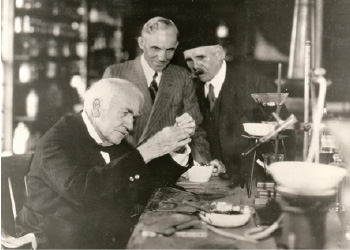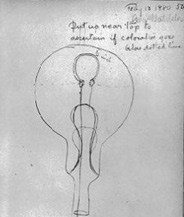Chapter Ten
Light’s Golden Jubilee

Edison reenacts his invention of the incandescent light bulb while Henry Ford and former mucker Francis Jehl look on.
By the late 1920s, Edison’s greatest days as an inventor were behind him. With age, he had slowed down and spent more time relaxing at his home in Florida and less time inventing.
Fifty years earlier, Edison had invented the incandescent light bulb and a system to power it. It was an invention that had changed the face of civilization. October 21, 1929, was an anniversary that demanded a celebration, and Americans were ready.
Many special events were organized to honor this 50th anniversary and the man responsible for it. At the center of attention was Light’s Golden Jubilee, an extravaganza hosted by Edison friend and automobile manufacturer Henry Ford at Ford’s newly completed museum, the Edison Institute of Technology (known today as The Henry Ford) in Dearborn, Michigan.
The anniversary day began in dramatic fashion. A replica of an 1860 steam train, similar to those on which Edison sold newspapers as a young boy, carried the Fords, the Edisons, and President and Mrs. Herbert Hoover from Detroit (Michigan) to Dearborn. An admiring crowd of invited guests, including scientists, industrialists, celebrities, and politicians, met the train at the station in Dearborn’s Greenfield Village.
From there, the elderly Edison traveled to the Fords’ home for a quiet afternoon. The guests, however, remained in Greenfield Village, where horse-drawn carriages took them on tours of the surroundings. The streets were lined with historically important American buildings from all around the country, which Ford had bought and moved to Dearborn. Of particular interest was the reconstruction of Edison’s Menlo Park (New Jersey) complex, the site where Edison had had his first practical success with electric light.
A formal dinner was held that evening in a replica of Independence Hall, the Philadelphia, Pennsylvania, landmark. The star-studded crowd included aviation pioneer Orville Wright; chemist and Nobel Prize winner Marie Curie; oil magnate and philanthropist John D. Rockefeller, Jr.; J.P. Morgan, Jr.; and humorist Will Rogers. While guests feasted, speakers praised Edison and his accomplishments. NBC radio conducted a live broadcast from the banquet hall, bringing the event into homes across the country.
At the end of the first round of speeches, radio coverage moved to the reconstructed Menlo Park lab, where Edison and an assistant, Francis Jehl, sought to repeat their first successful experiment with the incandescent lamp. The radio report, transmitted over national airwaves, captured the suspense and excitement of the moment:

One of Edison’s early sketches of the light bulb
“Will it light? Will it burn? Or will it flicker and die, as so many previous lamps had died? Oh, you could hear a pin drop in this long room.... Mr. Edison has the two wires in his hand; now he is reaching up to the old lamp; now he is making the connection. It lights! Light’s Golden Jubilee has come to a triumphant climax.... And now let us go for a minute to the belfry of Independence Hall and listen to the replica of the Liberty Bell as it tells the world that Edison’s light has been born anew.”
Publicity in advance of the radio broadcast had urged Americans to listen in darkness, as a reminder of the days before electrification, and then to turn on their lights at the tolling of the Liberty Bell. “I can imagine...all the cities of the country, big and small, as they come out of the darkness into light,” exclaimed the radio reporter.
In addition to listening to the radio broadcast, many towns and cities across America organized their own tributes to Edison. The National Electric Light Association Bulletin, a trade magazine, provided a range of suggestions: bonfires, boats outlined with lights, fireworks, parades, essay contests, and library book exhibits.
Light’s Golden Jubilee even reached an international audience. Alberto Pirelli, president of the International Chamber of Commerce, spoke for many when he remarked: “Mr. Edison happens to have been born in the United States, but he belongs to the world.” Nations from Japan to Austria caught “Edison fever,” hosting conferences, fairs, and light carnivals. And special light displays graced a number of foreign embassy buildings in Washington, D.C.
Thomas Alva Edison, citizen of the world, achieved enormous fame during his lifetime. In the words of an anonymous writer, Light’s Golden Jubilee provided an opportunity for people to “stand beside the man whose genius made possible a world forever free of darkness—a world of increasing productivity—a world of growing comfort, of expanding safety and improving health, and consider with him what 50 years have wrought.”